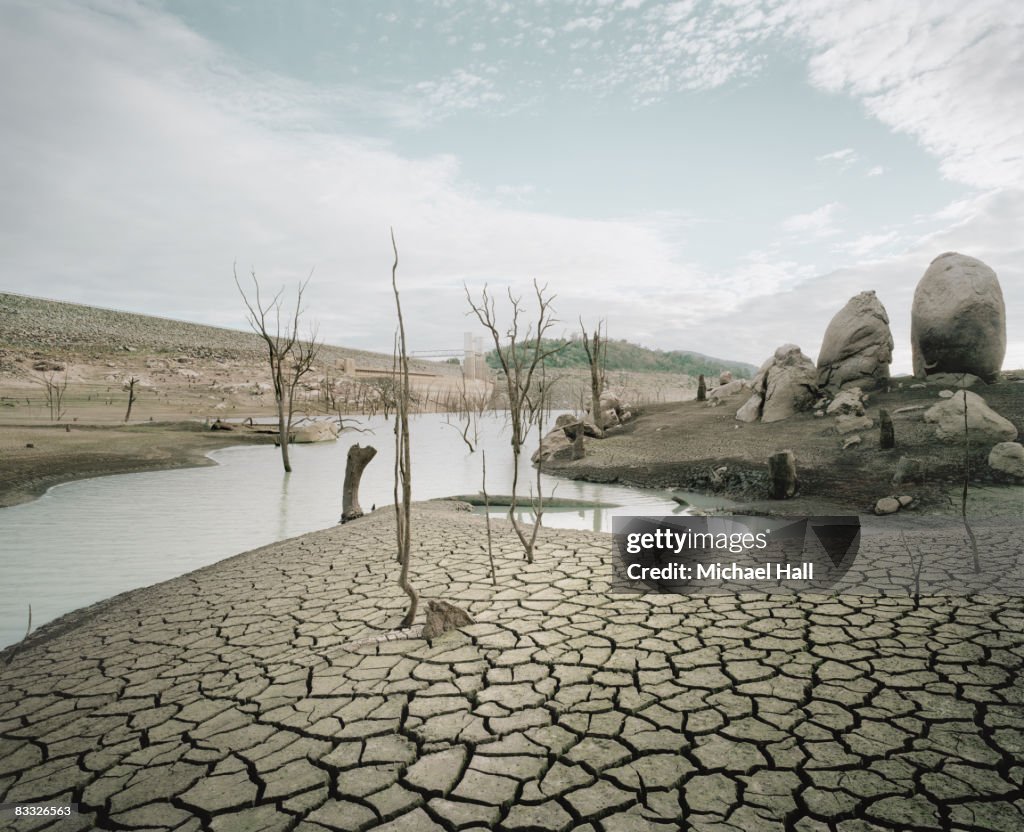
Climate change poses a major threat to human health. It disrupts the natural environment as well as all dimensions of both ecological and human systems – including economic and social conditions, along with the operation of health services. It therefore acts as a risk amplifier, potentially undoing decades of health advancements. As the climate shifts, extreme and more frequent events such as storms, heatwaves, floods, droughts, and wildfires are being observed. These hazards impact health both directly and indirectly, raising the likelihood of deaths, chronic illnesses, infectious disease outbreaks, and health crises.
The effects of climate change are also felt within health infrastructure and the workforce, lowering the ability to achieve universal health coverage (UHC). More broadly, climate shocks and ongoing stressors – such as altered rainfall and temperature patterns, droughts, floods, and rising sea levels – erode the environmental and social foundations of both physical and mental health. Climate change touches every aspect of human well-being, from access to clean air, safe water, and fertile soil to secure food supplies and livelihoods. Postponing action on climate change will heighten health threats, reverse decades of global health progress, and violate the shared commitment to uphold the human right to health for everyone.
Read more about Latest movies blog in the world
Read more about Climate change and its effect
The Intergovernmental Panel on Climate Change (IPCC) Sixth Assessment Report (AR6) highlighted that climate risks are emerging faster and becoming more severe sooner than anticipated, making adaptation increasingly difficult as global warming intensifies.
The report also found that 3.6 billion people already reside in areas highly exposed to climate threats. Despite contributing the least to greenhouse gas emissions, low-income countries and small island developing states (SIDS) suffer the most severe health consequences. In vulnerable regions, death rates from extreme weather over the past decade were 15 times higher than in less exposed regions.
Climate change influences health in numerous ways: causing illness and death from more frequent extreme weather events like heatwaves, storms, and floods; disrupting food systems; increasing the spread of zoonotic, foodborne, waterborne, and vector-borne diseases; and contributing to mental health problems. It also weakens many of the social foundations of good health, including livelihoods, equity, access to health services, and social support networks. These climate-sensitive health risks fall hardest on the most vulnerable and marginalized groups, such as women, children, ethnic minorities, impoverished communities, migrants or displaced populations, older adults, and people with pre-existing health conditions.
It is undeniable that climate change has profound effects on human health, yet precisely measuring the magnitude and consequences of climate-sensitive health risks remains complex. Nonetheless, progress in scientific research is increasingly enabling experts to link rising levels of illness and death to global warming, and to more reliably quantify the scale of these threats.
According to WHO figures, 2 billion people lack access to safe drinking water, and 600 million fall ill each year from contaminated food, with children under five accounting for nearly one-third of the fatalities. Climate-related pressures further intensify the risks of both foodborne and waterborne diseases. In 2020, 770 million individuals were undernourished, with the majority residing in Africa and Asia. Climate change disrupts food production, availability, and nutritional diversity, worsening food security and malnutrition crises.
Shifts in temperature and rainfall patterns fuel the spread of vector-borne diseases. Without proactive interventions, annual deaths from these illnesses—already exceeding 700,000—are likely to climb. The climate crisis also has major psychological consequences, triggering acute mental health conditions such as anxiety and post-traumatic stress, as well as long-term disorders linked to displacement and weakened community ties.
Studies suggest that 37% of heat-related deaths can be traced to human-driven climate change. Mortality linked to extreme heat among people over 65 has surged by 70% over the past twenty years. In 2020 alone, 98 million more people faced food insecurity compared to the 1981–2010 average. WHO estimates project an additional 250,000 deaths annually by the 2030s, driven by factors such as malaria and coastal flooding. Still, modelling these outcomes remains difficult, especially when accounting for risks tied to drought and migration.
This crisis threatens to reverse half a century of gains in global health, poverty reduction, and development, while worsening existing health disparities within and between populations. It also undermines progress toward universal health coverage (UHC), not only by increasing the overall disease burden but also by creating new barriers to healthcare access—particularly at times of greatest need. Today, over 930 million people—about 12% of the global population—spend at least 10% of their household income on medical care. With the poorest often lacking insurance, health shocks push around 100 million people into poverty each year, a figure that climate change is set to intensify.
In the near future, the health consequences of climate change will depend largely on population vulnerability, adaptive capacity, and resilience to current warming trends. In the longer term, outcomes will hinge on how quickly and decisively emissions are reduced to avoid surpassing dangerous temperature thresholds and irreversible tipping points.
Although climate risks are universal, those suffering the earliest and most severe health harms are communities that have contributed the least to global emissions and are least equipped to shield themselves. This reality highlights the equity dimension of climate action: the highest responsibility for financing adaptation and mitigation should rest with the major emitters, ensuring that vulnerable groups are prioritized.
Preventing catastrophic health consequences and saving millions of lives requires limiting global warming to 1.5°C. Past emissions mean some degree of climate change is unavoidable, but even 1.5°C of warming cannot be considered safe. Every fraction of a degree beyond this will exact a serious and escalating toll on human health and survival.
The Sun is the main source of energy for Earth’s climate system. A portion of the incoming solar radiation is immediately reflected back into space, especially by bright surfaces like clouds and ice, while the rest is absorbed by Earth’s surface and atmosphere. Much of this absorbed energy is then released as heat in the form of infrared radiation. The atmosphere captures and re-emits some of this heat, with part of it escaping to space. Any disruption in the balance between incoming and outgoing energy can influence the climate. For instance, even slight variations in the Sun’s energy output can directly affect this balance.
If all the heat emitted from Earth’s surface escaped directly into space without interacting with the atmosphere, the planet’s average surface temperature would be many degrees colder than it is today. Greenhouse gases—such as water vapor, carbon dioxide, methane, and nitrous oxide—trap and re-radiate heat in all directions (including back toward the surface), keeping the lower atmosphere and Earth’s surface much warmer [Figure B1]. Without this natural greenhouse effect, the kind of life we know today would not be possible. Increasing the concentration of greenhouse gases in the atmosphere strengthens this effect by reducing the amount of heat that can leave the planet. When more energy enters than exits, Earth warms until it reaches a new equilibrium.
Human activities release greenhouse gases, shifting Earth’s energy balance and thereby changing the climate. People also influence climate by altering land surfaces (such as clearing forests for agriculture) and by producing pollutants that modify the composition and behavior of particles in the atmosphere.Research shows that, considering both natural and human influences, Earth’s energy balance has shifted toward warming, with rising carbon dioxide levels being the largest driving factor.
Since the start of the Industrial Revolution, the levels of carbon dioxide, methane, and nitrous oxide in the atmosphere have risen substantially. For carbon dioxide in particular, measurements from the Mauna Loa Observatory in Hawaii show an increase from 316 parts per million (ppm) in 1959 (the first full year of recorded data) to over 411 ppm by 2019 [Figure B2]. Comparable growth rates have been observed at monitoring stations around the globe. Relative to preindustrial times, atmospheric CO2 has climbed by more than 40%, methane has surged by over 150%, and nitrous oxide has grown by roughly 20%. More than half of the total CO2 rise has taken place since 1970. All three gases contribute to global warming, but carbon dioxide remains the dominant factor. See page B3 for more information about the sources of greenhouse gases from human activity.
Researchers have also studied greenhouse gases in a historical context. Analyses of air bubbles trapped in Antarctic ice show that CO2 levels began to climb significantly in the 19th century [Figure B3], after remaining steady between 260 and 280 ppm for roughly 10,000 years. Ice core records stretching back 800,000 years reveal that CO2 fluctuated between 170 and 300 ppm during repeated ice age cycles — and never exceeded 300 ppm until the last two centuries.
Isotopic studies of carbon in today’s atmosphere provide clear evidence of the addition of “old” carbon (low in radioactive 14C) released by burning fossil fuels, as opposed to “new” carbon from living systems. Furthermore, human activities (excluding land-use changes) are estimated to release about 10 billion tonnes of carbon into the air each year, mostly through fossil fuel combustion — more than enough to account for the observed rise in CO2. Taken together, these lines of evidence show conclusively that the increase in atmospheric CO2 is the direct result of human actions.
Determining the rise in global average surface air temperature requires detailed examination of millions of measurements collected worldwide from land-based stations, ocean vessels, and satellites. Despite the challenges of combining such diverse data, several independent scientific groups have separately and consistently concluded that the planet’s average surface temperature has increased by roughly 1 °C (1.8 °F) since 1900 [Figure B4]. While the record shows intervals of slower and faster warming, each of the past four decades has been hotter than any previous decade since instrumental records began in 1850.
Before the widespread use of reliable thermometers, scientists rely on climate “proxies” such as tree rings, ice cores, and ocean sediments to reconstruct past temperatures. Comparisons of these proxies with thermometer-based records indicate that the period beginning in the early 1980s marks the warmest continuous 40 years in at least the last 800 years, and that current warming is approaching peak temperatures last reached 5,000–10,000 years ago during the warmest stage of the current interglacial epoch.
The ongoing warming has also led to many observable consequences in recent decades. Arctic summer sea ice has decreased sharply. The ocean’s heat content has grown significantly. Since 1901, the global average sea level has risen by about 16 cm (6 inches), caused both by thermal expansion of warmer seawater and by meltwater from glaciers and ice sheets on land. Shifts in temperature and rainfall patterns are altering the habitats and seasonal cycles of numerous plant and animal species. Beyond climate effects, some of the excess atmospheric CO₂ is being absorbed by the oceans, changing seawater chemistry and leading to ocean acidification.




